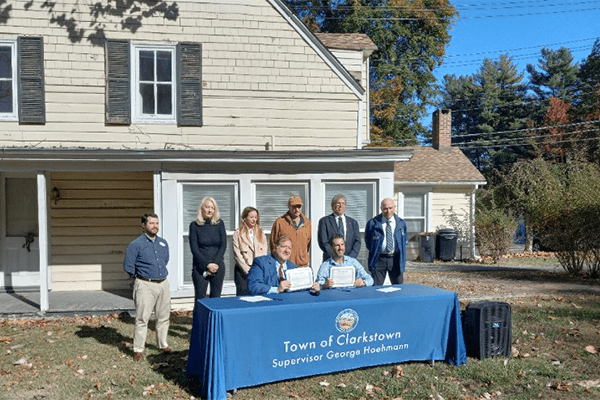|
RCBJ-Audible (Listen For Free)
|
Donation Gives Clarkstown A Chance To Preserve An Important 1765 House But Clarkstown Is Looking At Significant Renovation Costs
By Tina Traster
Anyone who has purchased or inherited an historic house understands the endeavor is laden with responsibility, financial wherewithal, and commitment. Surviving houses of the 18th and early 19th century capture the imagination, preserve and enrich the character of a neighborhood, and hold the kind of history and lore that gets passed along to the next generation.
If these treasures are not maintained, inside and out, they succumb to bulldozers, as we have seen time and again.
After two decades of owning and renting the historic house at 407 Storms Road in Valley Cottage, Tilcon Minerals Inc. donated the house to the Town of Clarkstown. The donation presents an opportunity to preserve an important pre-Revolutionary structure. But Clarkstown will have its work cut out for it because it will take many tens of thousands of dollars to bring the house into repair, both inside and out.
Town officials, alongside Tilcon management, held a ceremony on Friday to celebrate the donation of the house, which the mining company purchased in 2005 for $492,500 from the De Lima Greene family. The house had been in the Greene family for a century.
“Due to the generosity of Tilcon, we are saving a piece of the town’s treasured history,” said Town Supervisor George Hoehmann, during the ceremony.
But for the last two decades, the house has been severely neglected and fallen into a state of disrepair, with an odd wall erected between a living room and the hall, rotted wood, unstable railings and fittings, worn fixtures and flooring. In short, if a homeowner bought the house, they would be looking at a total restoration to bring the house up to modern living standards while preserving historical elements. Replacement of the tiny, worn-out kitchen and bathroom on ground level alone could cost well over $100,000.
Zillow estimates the 1,872 square-foot house would sell for around $729,000, though the online real estate company uses comparables of area house sales of similar size to generate estimates. The algorithm doesn’t account for the interior condition of the house or for deferred maintenance.
On the open market, the house might sell for less, realtors agree, because of its downtrodden condition. However, many people have a penchant for old houses and are willing to rescue and revitalize them, though they understand it costs a pretty penny in investment dollars beyond the sales price.
Tilcon, the owner of the 407 Storms Road house on a 1.6-acre property, had been paying $5,500 in property taxes to the town and county, and $8,100 to the Nyack School District. With the donation, the property will come off the tax rolls.
On a personal note, I bought an 1850s farmhouse 20 years ago this Halloween. Most would have considered it a teardown. We still think the realtor showed us the house in the hope that it would scare us and motivate us to buy another one she’d showed us beforehand. But I’m among a crazy cohort of people who fall for an old house, rescue it, and are in its clutches until the day we let it go. As they say, an old house owns you.
For now, the town has no specific plan in place for its restoration or use.
“We’d like to hear from the residents,” said Hoehmann, adding it could be used as a public space or for volunteer emergency services.” There is limited parking space on site.
“We will pursue grants, and we will look into getting the house on the state and federal historic registries.”
Alison De Lima Greene ended a century of her family’s ownership of the house when she sold it to Tilcon. Her parents died in the late 1990s and she lives in Texas. Greene, who is a curator at the Houston Museum of Fine Arts and has published many works on modern art, says she’s delighted the house has been saved.
“It put a big smile on my face,” said Greene. “But I hope the town has the resources. The house has gone through many transformations, from an inn to a feed store to a family refuge. I had a fabulous life there. It would be great if it could be occupied by a family again.”
Greene said it’s a hard house to maintain; one that renters would find difficult to upkeep.
“The insulation isn’t great,” she said. “It’s expensive to heat, and the biggest problem is that water drains down the hill and flows into the basement.”
She added, “but houses are well looked after when they are occupied.”
Greene’s grandmother Agnes de Lima, an educated writer and thinker born in 1887, bought the house in 1921. The house passed along to Agnes’s only daughter Sigrid de Lima and her husband Stephen Greene, an acclaimed abstract painter, in the mid-1950s. The Greenes initially used the house as a summer cottage, but Alison recalls moving up to Valley Cottage from New York City when she was around 10 years old.
“I knew this was a special house,” Greene said, alluding to legends that say the Continental Army forces once quartered here, backed their horses down Casper Hill to confuse the oncoming British and make their own escape. Allegedly the house hosted George Washington. Half a century later the house became a way station on the Underground Railroad by which runaway slaves escaped to the north, according to New York Heritage.
Greene, whose family lived and socialized among storied local writers and artists, remembers her father kept his painting studio in the barn, which is still there, and her mother, a fiction writer, treasured her garden of wildflowers and berries. Her mother collected a menagerie of animals from the backwoods along Route 303. She spoke nostalgically about sleeping on the porch during the summer.
When the Greenes moved into the Valley Cottage house, they found many kindred spirits among the loosely knit community of artists including Jasper Johns and “Irascible” Richard Pousette-Dart. The writer Harvey Swados and his wife Bette, an editor, were immediate neighbors and close friends through much of the 1960s. Other close friends of the Greenes included artist Eugene Powell and his wife Neva (an educator), printmaker Sylvia Roth, MoMA curator Mildred Constantine, and mystery writer Dorothy Davis and her husband, actor Harry Davis.
The Greenes lived in the house through nearly every major notable era in 20th century America. Greene attended Valley Cottage Elementary but went to Rockland County Day School, which she called “Hippie High.” Growing up the only child of both Ashkenazi and Sephardic Jews in a mostly Christian community, she finished high school abroad and went on to Vassar College. After graduating, she lived in Manhattan but looked after the house until her parents died.
Greene says having lived in an historic house shaped her childhood, but she said her family wasn’t special because they lived in the house. It was the house that was special, she added, wistfully.













